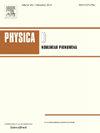A modified Korteweg–de Vries equation soliton gas on a nonzero background
IF 2.9
3区 数学
Q1 MATHEMATICS, APPLIED
引用次数: 0
Abstract
In this paper, we consider a soliton gas of the focusing modified Korteweg–de Vries generated from the -soliton solutions on a nonzero background. The spectral soliton density is chosen on the pure imaginary axis, excluding the branch cut . In the limit , we establish the Riemann–Hilbert Problem of the soliton gas. Using the Deift-Zhou nonlinear steepest-descent method, this soliton gas on a nonzero background will decay to a constant background as , while its asymptotics as can be expressed with a Riemann Theta function, attached to a Riemann surface with genus-two. We also analyze the large asymptotics over the entire spatial domain, which is divided into three distinct asymptotic regions depending on the ratio . Using the similar method, we provide the leading-order asymptotic behaviors for these three regions and exhibit the dynamics of large asymptotics.
非零背景下的修正Korteweg-de Vries方程孤子气体
本文考虑了在非零背景下由n -孤子解产生的聚焦修正Korteweg-de Vries孤子气体。谱孤子密度选择在纯虚轴上,排除分支切断Σc=−i,i。在极限N→∞下,建立了孤子气体的黎曼-希尔伯特问题。利用Deift-Zhou非线性最陡下降法,该孤子气体在非零背景下,当x→+∞时衰减到一个常数背景,而其渐近性可以用黎曼Theta函数表示,该函数附属于一类- 2黎曼曲面。我们还分析了整个空间域上的大t渐近性,根据比例ξ=xt将其划分为三个不同的渐近区域。利用类似的方法,我们给出了这三个区域的首阶渐近行为,并展示了大t渐近的动力学性质。
本文章由计算机程序翻译,如有差异,请以英文原文为准。
求助全文
约1分钟内获得全文
求助全文
来源期刊

Physica D: Nonlinear Phenomena
物理-物理:数学物理
CiteScore
7.30
自引率
7.50%
发文量
213
审稿时长
65 days
期刊介绍:
Physica D (Nonlinear Phenomena) publishes research and review articles reporting on experimental and theoretical works, techniques and ideas that advance the understanding of nonlinear phenomena. Topics encompass wave motion in physical, chemical and biological systems; physical or biological phenomena governed by nonlinear field equations, including hydrodynamics and turbulence; pattern formation and cooperative phenomena; instability, bifurcations, chaos, and space-time disorder; integrable/Hamiltonian systems; asymptotic analysis and, more generally, mathematical methods for nonlinear systems.
 求助内容:
求助内容: 应助结果提醒方式:
应助结果提醒方式:


